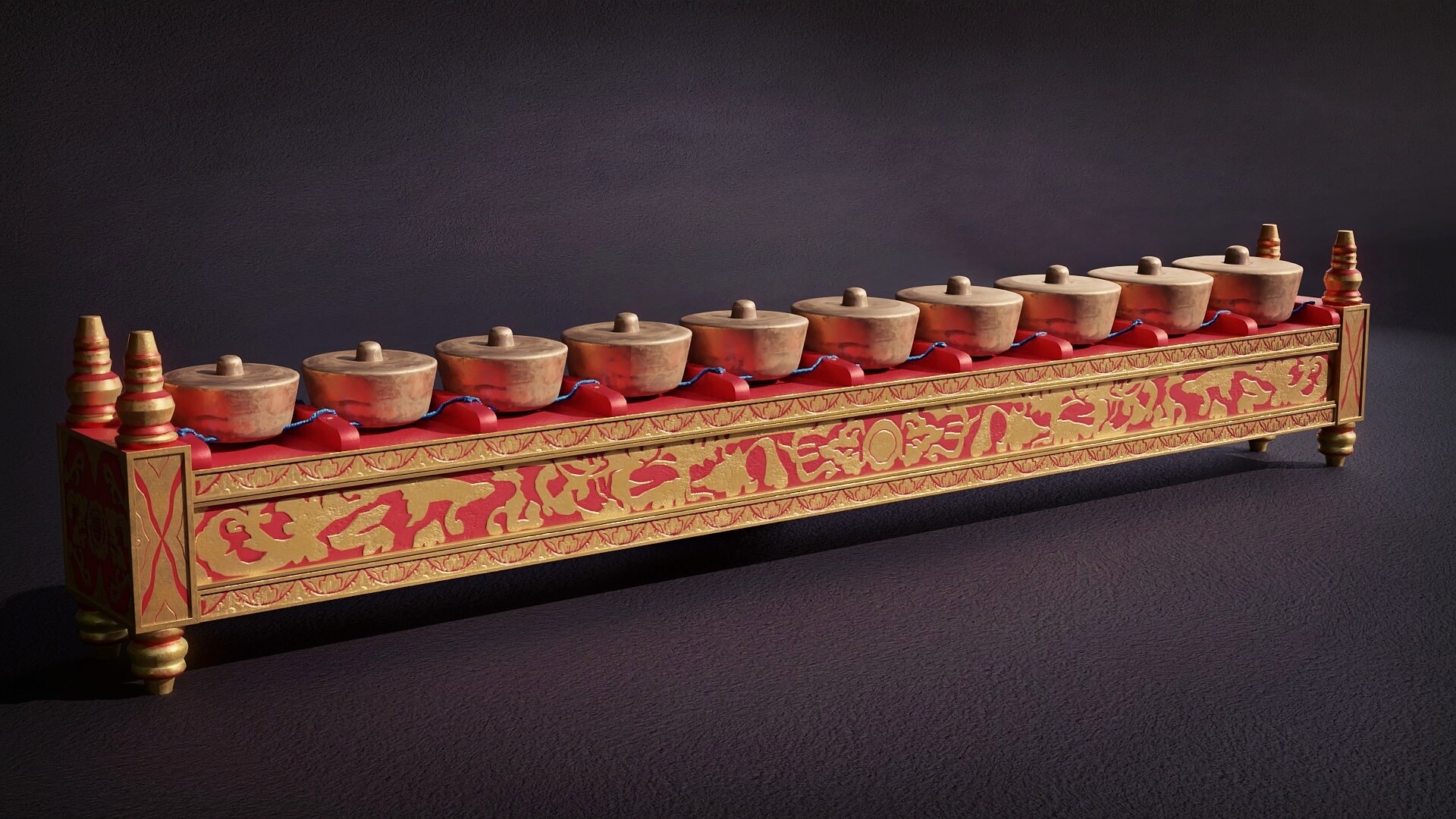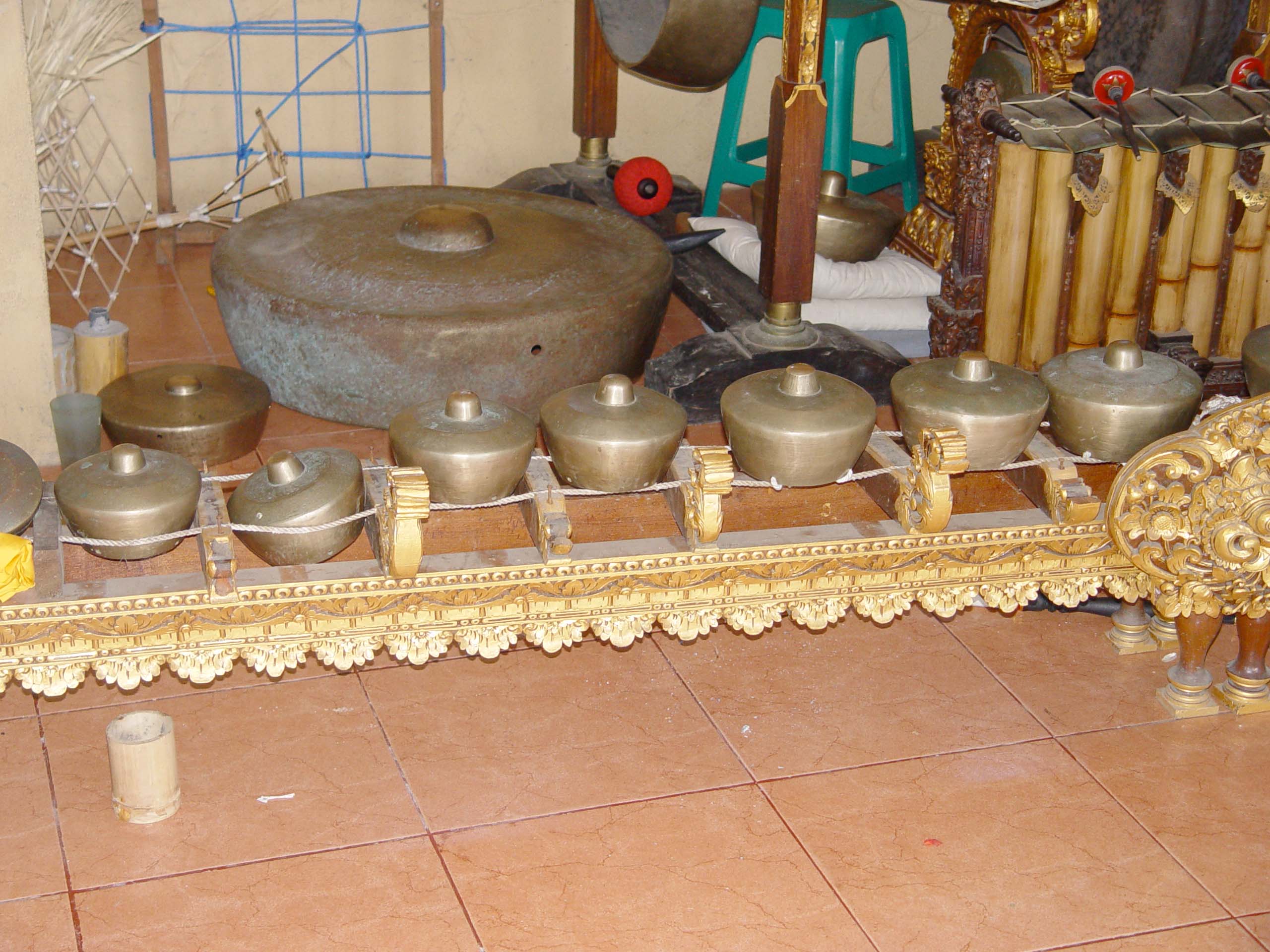Reyong
Melodic Percussions
Asia
Between 0 and 1000 AD
Video
The Reyong is a traditional percussion instrument that originates from Southeast Asia, particularly in Indonesia, where it is prominently used in Balinese gamelan ensembles. It is classified as an idiophone, meaning it produces sound through the vibration of its own material without the need for strings or membranes. The Reyong consists of a row of small, horizontally suspended metal gongs that are played with mallets. These gongs are typically made from bronze or brass, materials known for their rich and resonant tonal qualities.
The instrument is usually played by multiple performers who strike the gongs in rapid succession, producing intricate interlocking rhythms. The number of gongs in a Reyong set can vary, but it commonly consists of eight to twelve gongs arranged in a row on a wooden frame. Each gong is carefully tuned to a specific pitch, allowing the instrument to contribute to the melodic and rhythmic complexity of a gamelan performance.
The Reyong is an essential component of the gamelan gong kebyar ensemble, a dynamic and expressive style of Balinese music known for its sudden tempo shifts and powerful, dramatic sound. The instrument’s rapid, syncopated playing technique adds to the energetic and percussive nature of the ensemble, making it a crucial element in Balinese musical traditions.
History and Origin
Continent and Regional Roots
The Reyong originates from the Southeast Asian region, specifically Indonesia, where it is an integral part of Balinese and Javanese gamelan music. Gamelan music itself has a long and rich history, dating back to at least the 9th century CE. Historical records and inscriptions from the ancient Javanese Majapahit Empire (13th–16th century) indicate the presence of bronze percussion instruments similar to the Reyong. Over time, these instruments evolved into various forms, including the Reyong, which became an essential part of Balinese musical culture.
Gamelan music, and by extension the Reyong, is deeply rooted in Hindu-Buddhist traditions that influenced the Indonesian archipelago for centuries. The arrival of Indian traders and religious influences introduced new artistic and musical practices to the region, which blended with indigenous cultural elements to create the unique sound of gamelan music. The Reyong, as part of this musical evolution, developed as an idiophonic instrument with specific playing techniques suited to the intricate rhythmic structures of gamelan compositions.
Century of Development and Spread
While gamelan music dates back to ancient times, the Reyong gained prominence during the Majapahit period (13th–16th century) and became more widespread in Bali after the decline of the Majapahit Empire in the 16th century. During this period, many Javanese musicians and artists migrated to Bali, bringing with them their musical knowledge and traditions. This migration played a significant role in shaping Balinese gamelan music, leading to the development of new ensembles and instrumental roles, including the Reyong.
By the 19th and 20th centuries, gamelan music had become a fundamental part of Balinese temple rituals, dance performances, and community events. The Reyong’s role within gamelan ensembles continued to evolve, with musicians developing new techniques and compositions that showcased its versatility. Today, the Reyong remains a central instrument in Balinese cultural life, performed in traditional ceremonies, festivals, and even contemporary musical adaptations.
Types and Features of the Reyong
Variations in Design and Construction
The Reyong comes in different variations, depending on the type of gamelan ensemble in which it is used. The most common form is found in the gamelan gong kebyar and gamelan beleganjur ensembles, each with distinct playing styles and functions.
Gamelan Gong Kebyar Reyong: This version is characterized by fast, dynamic, and syncopated playing techniques. The gongs are often played in rapid sequences, creating a shimmering and percussive effect that enhances the dramatic quality of gong kebyar performances.
Gamelan Beleganjur Reyong: Used in processional music, this version of the Reyong is played in a more rhythmic and repetitive manner to accompany marching musicians. The Reyong in this ensemble provides a steady rhythmic foundation, complementing the powerful sounds of larger gongs and drums.
Gamelan Semar Pegulingan Reyong: This type is found in an older form of gamelan music that is more melodic and refined. The playing style is less aggressive, with smoother transitions and more emphasis on tonal clarity.
Regardless of the ensemble, the Reyong’s gongs are arranged in a linear sequence and are often tuned to the five-tone or seven-tone pelog and slendro scales, which are unique to gamelan music. The instrument is typically decorated with intricate carvings and painted in vibrant colors, reflecting the artistic traditions of Balinese craftsmanship.
Playing Techniques and Musical Features
The Reyong is played using a technique called “kotekan,” which involves interlocking rhythmic patterns performed by multiple players. The instrument is usually played by two to four musicians, each responsible for striking specific gongs in a coordinated manner. This technique creates complex rhythmic textures and rapid sequences that are characteristic of Balinese gamelan music.
Each player uses a pair of wooden mallets with padded ends to strike the gongs. The speed and force of the strikes determine the dynamic range of the instrument, allowing for both subtle and powerful expressions. The interplay between players requires precise timing and coordination, making the Reyong one of the more challenging gamelan instruments to master.
Work Mechanics of the Reyong
The mechanics of the Reyong involve the interaction between the musician, the mallets, and the suspended metal gongs. The instrument operates through the principles of resonance and vibration. When struck, each gong produces a distinct pitch, with the larger gongs producing lower frequencies and the smaller gongs producing higher frequencies.
The gongs are mounted on a wooden frame using cords or leather straps, allowing them to vibrate freely when struck. This setup enhances the resonance and sustain of each gong, contributing to the rich, layered sound of the instrument. The arrangement of the gongs follows a specific tuning system, ensuring that the pitches complement other instruments in the gamelan ensemble.
The physical mechanics of playing the Reyong involve precise wrist movements and coordinated strikes to maintain the rapid tempo and syncopated rhythms characteristic of gamelan music. Experienced musicians develop advanced techniques such as dampening certain gongs to control sustain and using dynamic variations to emphasize specific beats within a composition.
Role in Music and Cultural Significance
Role in Traditional and Contemporary Music
The Reyong plays a vital role in both traditional and contemporary Balinese music. In traditional settings, it is used in religious ceremonies, dance performances, and temple rituals. The instrument’s rapid and complex rhythms enhance the energy of ceremonial music, creating a lively and immersive auditory experience.
In contemporary music, the Reyong has been incorporated into fusion projects that blend gamelan with modern genres such as jazz, electronic, and experimental music. Some composers and musicians have explored the potential of the Reyong outside of traditional gamelan settings, using its percussive qualities to add unique textures to global music compositions.
Spiritual and Cultural Importance
Beyond its musical role, the Reyong holds deep cultural and spiritual significance in Balinese society. Gamelan music, including the sounds of the Reyong, is believed to have divine origins and is often associated with Hindu-Balinese religious practices. The instrument is played during temple ceremonies, where its rhythms are thought to communicate with the gods and spirits.
The Reyong is also an integral part of traditional dance performances such as the Barong dance, where it helps narrate mythological stories through sound and movement. In community events, the instrument fosters social cohesion, as playing gamelan requires teamwork, discipline, and collaboration among musicians.
The Reyong is a remarkable percussion instrument that embodies the rich musical and cultural heritage of Bali and Southeast Asia. With its intricate playing techniques, dynamic rhythms, and deep cultural significance, it remains a cornerstone of gamelan music. From its historical roots in the Majapahit era to its continued presence in modern-day performances, the Reyong has withstood the test of time, evolving while preserving its traditional essence.
FAQ
What is the historical origin of the Reyong instrument?
The Reyong originates from Bali, Indonesia, and has been part of Balinese gamelan music for centuries. Its exact historical origin is not well-documented, but it is deeply rooted in Balinese cultural practices.
What type of instrument is the Reyong?
The Reyong is a percussion instrument, specifically a type of gong-chime used in Balinese gamelan music. It is closely related to other instruments like the bonang.
What materials are typically used to make the Reyong?
The Reyong is typically made from metal gongs, often bronze or brass, suspended on a wooden frame. The gongs are tuned to specific pitches, often following the Balinese Pelog scale.
 Links
Links
References
Other Instrument
Categories



















